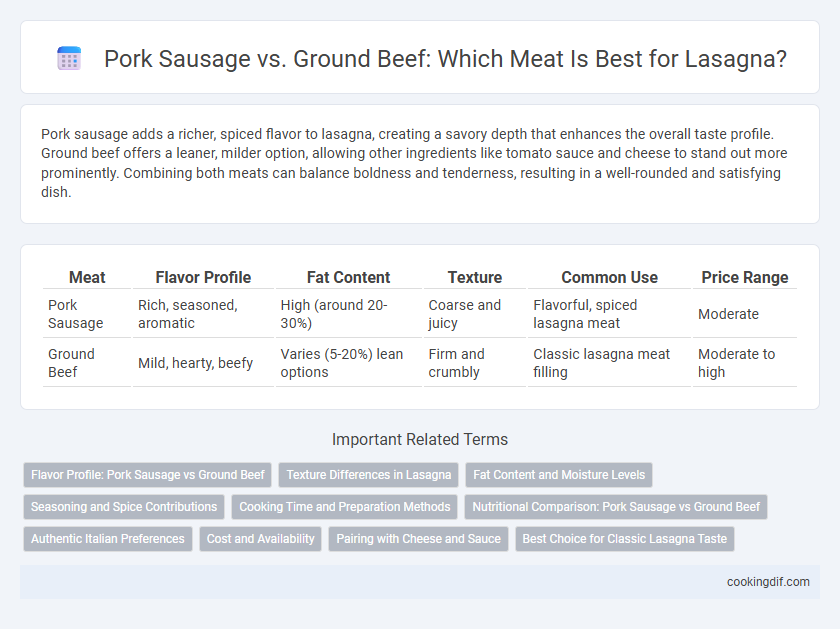Pork sausage adds a richer, spiced flavor to lasagna, creating a savory depth that enhances the overall taste profile. Ground beef offers a leaner, milder option, allowing other ingredients like tomato sauce and cheese to stand out more prominently. Combining both meats can balance boldness and tenderness, resulting in a well-rounded and satisfying dish.
Table of Comparison
| Meat | Flavor Profile | Fat Content | Texture | Common Use | Price Range |
|---|---|---|---|---|---|
| Pork Sausage | Rich, seasoned, aromatic | High (around 20-30%) | Coarse and juicy | Flavorful, spiced lasagna meat | Moderate |
| Ground Beef | Mild, hearty, beefy | Varies (5-20%) lean options | Firm and crumbly | Classic lasagna meat filling | Moderate to high |
Flavor Profile: Pork Sausage vs Ground Beef
Pork sausage imparts a rich, savory, and slightly spiced flavor to lasagna, often infused with herbs like fennel and garlic, adding depth and complexity. Ground beef offers a milder, beef-forward taste that provides a hearty base without overpowering other ingredients. Combining both meats balances robust seasoning with a classic, meaty richness, enhancing the overall flavor profile of lasagna.
Texture Differences in Lasagna
Pork sausage offers a tender, juicy texture with a slightly crumbly bite that enhances the overall mouthfeel of lasagna. Ground beef provides a firmer, denser texture that creates a hearty, substantial layer within the dish. Combining both meats balances the texture, delivering a richer, more complex eating experience.
Fat Content and Moisture Levels
Pork sausage typically contains higher fat content, averaging around 20-30%, which results in juicier and richer lasagna layers compared to ground beef, which usually has a leaner fat percentage between 10-15%. The increased moisture levels in pork sausage enhance the overall texture and flavor, preventing dryness in the meat mixture. Ground beef's lower fat and moisture content make it a leaner option, but may require added oils or sauces to maintain tenderness in lasagna.
Seasoning and Spice Contributions
Pork sausage infuses lasagna with bold, aromatic spices like fennel, garlic, and red pepper flakes, enhancing depth and complexity in every bite. Ground beef offers a milder, savory flavor that absorbs and balances herbs such as oregano and basil without overpowering the dish. Combining both meats creates a harmonious blend of spiced richness and hearty texture, elevating the overall seasoning profile of lasagna.
Cooking Time and Preparation Methods
Pork sausage typically requires a shorter cooking time than ground beef due to its higher fat content, which helps it brown faster and stay moist in lasagna. Preparation methods for pork sausage often involve removing the casing and crumbling the meat before sauteing, while ground beef is usually broken apart directly in the pan and cooked until evenly browned. Both meats benefit from browning over medium-high heat to develop rich flavors and ensure even cooking throughout the lasagna layers.
Nutritional Comparison: Pork Sausage vs Ground Beef
Pork sausage typically contains higher fat content and calories compared to ground beef, with around 270 calories and 23 grams of fat per 3-ounce serving versus 190 calories and 14 grams of fat in lean ground beef. Ground beef offers more protein per serving, providing approximately 22 grams, while pork sausage provides about 16 grams. Sodium levels are significantly higher in pork sausage due to added seasonings, often exceeding 500 mg per serving, whereas ground beef has minimal sodium unless seasoned.
Authentic Italian Preferences
Authentic Italian lasagna traditionally favors pork sausage due to its rich fat content and aromatic spices that enhance depth of flavor and texture. Ground beef, while commonly used outside Italy, tends to produce a leaner filling, lacking the complexity and moisture of pork sausage blends. Regional recipes consistently highlight pork sausage's role in achieving the rustic, hearty profile characteristic of classic Italian lasagna.
Cost and Availability
Pork sausage generally costs less than ground beef, making it a budget-friendly option for lasagna recipes. It is widely available in most supermarkets, often sold in bulk or pre-seasoned varieties, providing convenience and consistent flavor. Ground beef prices tend to fluctuate more based on fat content and quality, with leaner cuts usually priced higher and availability sometimes limited depending on the region.
Pairing with Cheese and Sauce
Pork sausage in lasagna pairs exceptionally well with creamy ricotta and mozzarella cheeses, enhancing the rich, savory flavors through its higher fat content and subtle sweetness. Its slightly spiced profile complements tomato-based sauces with herbs like basil and oregano, creating a balanced, layered taste. Ground beef provides a leaner, meatier texture that harmonizes with sharp Parmesan and tangy marinara, offering a robust, hearty flavor ideal for traditional Italian-style lasagnas.
Best Choice for Classic Lasagna Taste
Pork sausage offers a richer, spiced flavor that enhances the savory profile of classic lasagna, while ground beef provides a leaner, milder taste that complements tomato sauce without overpowering other ingredients. Combining both meats creates a balanced texture and depth, but pork sausage is often preferred by chefs aiming for an authentic, slightly spiced Italian flavor. Choosing high-quality, seasoned pork sausage can elevate the traditional lasagna experience, making it the optimal meat choice for true classic taste.
Pork sausage vs Ground beef for meat Infographic

 cookingdif.com
cookingdif.com